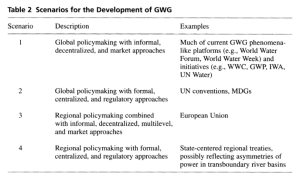Vogle’s account of watershed governance – its history and future – in the Columbia River provides a useful account of, first, the premise used for a reorganization of watershed management, and second, an application of this ideal conception of watershed governance to the Columbia River.
Vogel argues that, in the literature on watershed governance, four premises are used to justify reorganization to the watershed scale. She says that the reasoning/justification for a reorganization follows a causal sequence of arguments that leads from 1) natural boundaries, 2) holistic spaces 3) holistic management 4) positive social, environmental, economic and democratic outcomes (164).
In more detail, each of these premises provide justification for watershed governance. Specifically,
Natural Boundaries: river basins and watersheds have natural (i.e. related to physical and biological processes that influence water flow, aquatic, riparian and floodplain ecologies, and river and watershed form and evolution) boundaries (165)
Holistic Spaces: watersheds seen as holistic in their flow, in the people and communities within watersheds, interconnections of aquatic and riparian ecosystems and populations, ability to bring people and communities together, and the ability to bring different jurisdictions and agencies to cooperate (165-166).
Holistic Management Practices: due to holistic nature of watersheds and river basins, management practices are considered holistic in their integration of goals and areas, in their benefits distribution, and in their decision making that produces balanced management.
Improved social, environmental and economic outcomes: these are the expected outcomes from all of the above.
Vogel goes on to apply these four assumptions to the Columbia River, and finds that over the years and up to present, there has been mixed results. She argues that, due to “continuing political and legal power wrought by institutions, representatives, and constituents of conventional governmental spaces”, watershed governance reorganization has resulted in natural and political boundaries that led to both holistic and divided spaces, which shaped management into the recurring pattern of ‘parcelling out the watershed’, resulting in deeply mixed social, environmental, economic, and democratic outcomes (169).
Spaces are constructed. The meaning ascribed to them is a social, political, and economic construction. This is especially so in a transboundary water basin defined as a ‘region’ (Sneddon and Fox 2012). According to her analysis and historical reading, Vogel argues the Columbia River basin is “a product of the politics of conventional jurisdictions and territories; the boundaries of the governance territory built around the Columbia basin have not actually conformed to the hydrological borders of the basin”…it [the basin] is fundamentally both a natural and a political space” (173, 175). If we consider the implications of this, we can see the power of politics, economics, and biophysical processes to collaboratively, though perhaps inequitably, imprint meaning on and define our geographical areas.
In regards to the implementation of watershed governance, Vogel warns that challenges could still very well exist. Politics at multiple levels impacting on the basin could remain fragmented among “leaders, agencies courts, representatives and constituents of multiple jurisdictions” (182). However, be it as it may, the goal should be, at the last, to ensure that a level of communication is met which allows for coordination of activities within the basin, to ensure manager know where development is happening within the watershed, and policy makers understand the various processes at play on the ground. Perhaps, in this way, the goals of watershed governance can be met, at least in part.

